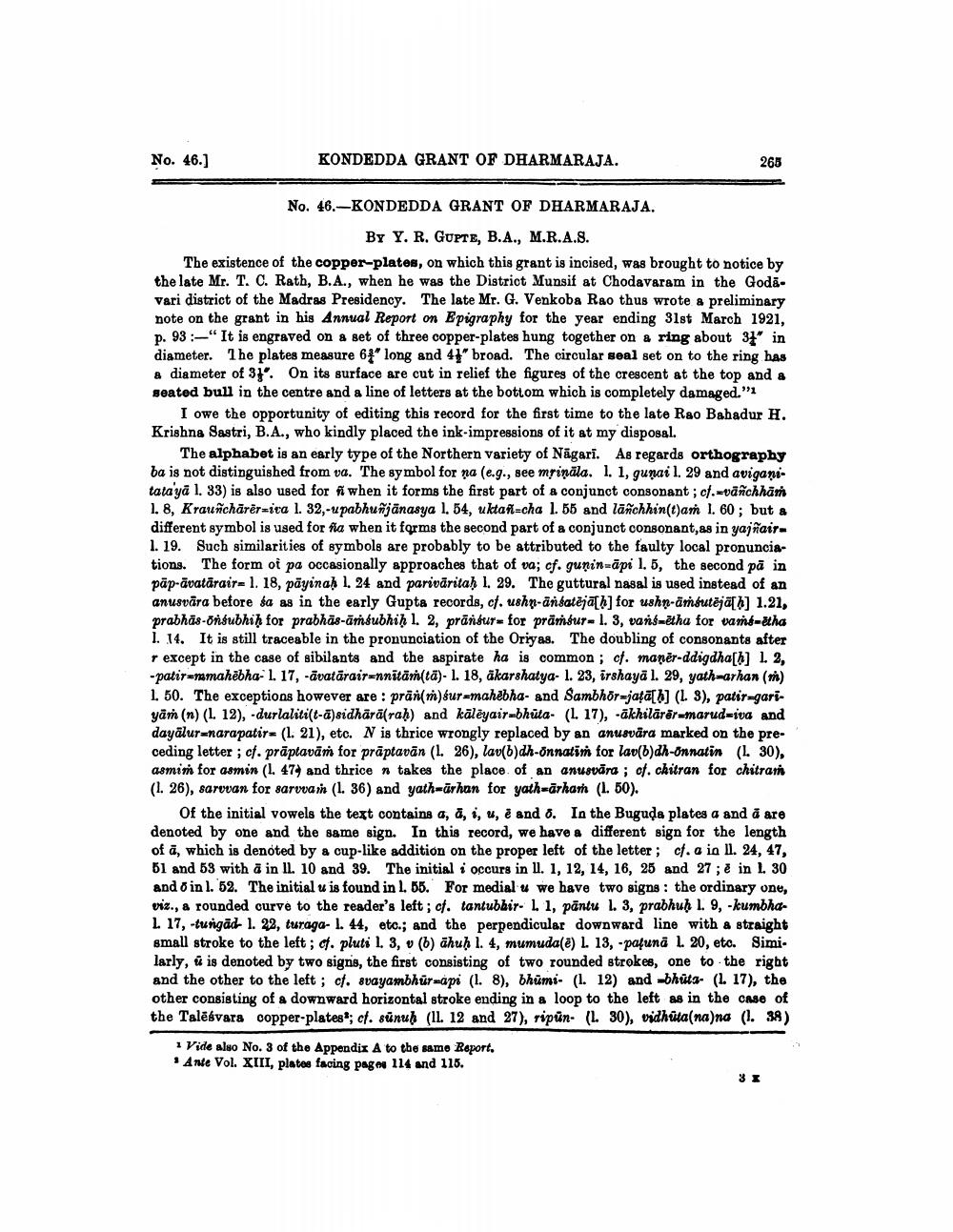________________
No. 46.)
KONDEDDA GRANT OF DHARMARAJA.
265
No. 46.-KONDEDDA GRANT OF DHARMARAJA.
By Y. R. GUPTE, B.A., M.R.A.S. The existence of the copper-plates, on which this grant is incised, was brought to notice by the late Mr. T. C. Rath, B.A., when he was the District Munsif at Chodavaram in the Godā. vari district of the Madras Presidency. The late Mr. G. Venkoba Rao thus wrote a preliminary note on the grant in his Annual Report on Epigraphy for the year ending 31st March 1921, p. 93 :-" It is engraved on a set of three copper-plates hung together on a ring about 34" in diameter. The plates measure 64 long and 41 broad. The circular seal set on to the ring has a diameter of 31. On its surface are cut in relief the figures of the crescent at the top and a seated bull in the centre and a line of letters at the bottom which is completely damaged."
I owe the opportunity of editing this record for the first time to the late Rao Bahadur H. Krishna Sastri, B.A., who kindly placed the ink-impressions of it at my disposal.
The alphabet is an early type of the Northern variety of Nāgari. As regards orthography ba is not distinguished from va. The symbol for na (e.g., see mrināla. 1. 1, gunai l. 29 and aviganitatayā 1. 33) is also used for fi when it forms the first part of a conjunct consonant; cf.=vāñchhän 1. 8. Kraunchārēruita l. 32,-upabhuñjānasya 1. 54, uktaft-cha 1. 58 and lanchhin(t)an I. 60; but a different symbol is used for a when it forms the second part of a conjunct consonant,as in yajñair1. 19. Such similarities of symbols are probably to be attributed to the faulty local pronunciations. The form oi pa occasionally approaches that of va; cf. gunin-āpi 1.5, the second pā in pāp-avatārair= 1. 18, pāyinaḥ 1. 24 and parivāritaḥ 1. 29. The guttural nasal is used instead of an anusvära before sa as in the early Gupta records, cf. ushn-ansatēja[b] for ushn-ärsutēja[6] 1.21, prabhās-onsubhiḥ for prabhās-āṁsubhiḥ 1. 2, prānbur= for prāṁbut= 1.3, vans-ětha for vamt-atha 1. 14. It is still traceable in the pronunciation of the Oriyas. The doubling of consonants after r except in the case of sibilants and the aspirate ha is common; cf. manēr-ddigdha[b] 1 2, - patir-namahēbha-1. 17, -avatārairunnitāṁ(tā)- 1. 18, äkarshatya- 1. 23, irshayā l. 29, yath-arhan (m) 1. 50. The exceptions however are: prān(m) sur-mahebha- and Sambhör-jatā[!] (L. 3), patir=gariyāṁ (n) (1. 12), -durlaliti(t-ā)sidhārā(rah) and kālēyair-bhūta- (1. 17), -ākhilārēr=marud=iva and dayālur=narapatir= (1. 21), etc. N is thrice wrongly replaced by an anusvāra marked on the preceding letter ; cf. prāptavāṁ for prāptavān (. 26), lav(b)dh-onnatin for lav(b)dh-onnatin (1. 30), asmim for asmin (1. 47, and thrice n takes the place of an anusvāra ; cf. chitran for chitran (1. 26), saruvan for sarvuar (1. 36) and yath=ūrhan for gath-ārham (L. 50).
Of the initial vowels the text contains a, a, i, u, è and . In the Buguda plates a and å are denoted by one and the same sign. In this record, we have a different sign for the length of ā, which is denoted by a cup-like addition on the proper left of the letter; cf.a ia II. 24, 47, 51 and 53 with à in IL 10 and 39. The initial i occurs in II. 1, 12, 14, 16, 25 and 27; & in l. 30 and o in l. 52. The initial u is found in L. 65. For medial u we have two signs: the ordinary one, viz., a rounded curve to the reader's left; cf. tantubbir. L 1, pantu l. 3, prabhuḥ 1. 9, -kumbhaL 17, -tungād 1. 22, turaga- 1. 44, etc.; and the perpendicular downward line with a straight small stroke to the left; cf. pluti L. 3, v (6) āhuḥ l. 4, mumuda(e) L. 13, -patuna L. 20, etc. Simi. larly, u is denoted by two signs, the first consisting of two rounded strokes, one to the right and the other to the left ; cf. svayambhur api (1. 8), bhūmi- (1. 12) and bhuta- (1. 17), the other consisting of a downward horizontal stroke ending in a loop to the left as in the case of the Talēsvara copper-plates; cf. sūnu) (11. 12 and 27), ripun- (1. 30), vidhūta(na)na (l. 38)
1 Vide also No. 3 of the Appendix A to the same Roport. Ante Vol. XIII, plates facing page 114 and 115.




